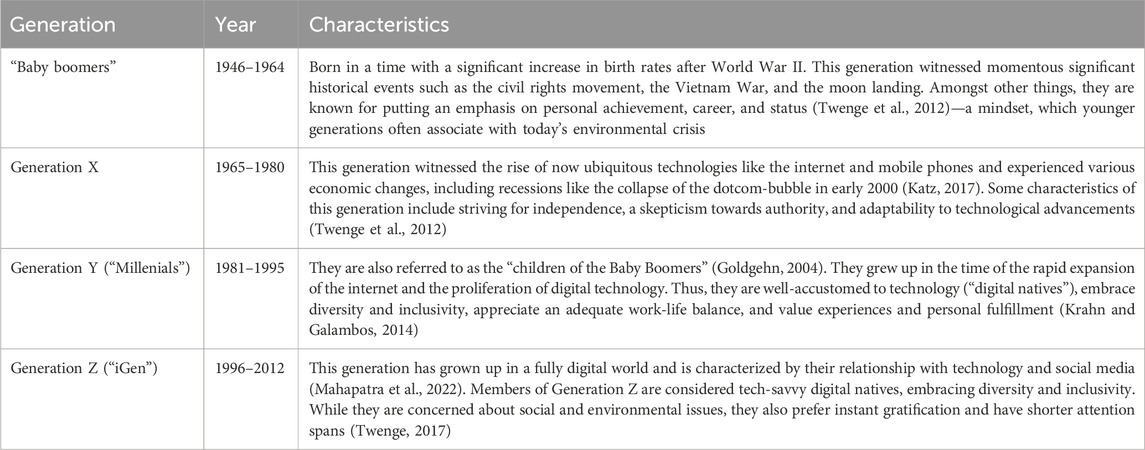- 1Affective & Cognitive Institute, Offenburg University, Offenburg, Germany
- 2Department of Architecture, University of Cambridge, Cambridge, United Kingdom
The Metaverse, a transformation of the internet by XR-technologies progressively blending the digital and physical world, is already changing our social structures. The success of VR-headsets like Quest has made both virtual worlds and the “metaverse” ubiquitous. This technological evolution yields the potential to fundamentally change the way we communicate, live, and work together. At the same time, the perceptions of how these worlds affect our lives differ considerably. To that end, this study investigates the perceptions of 115 younger people from the generations Y and Z, the potential “power users” of virtual worlds. In addition, it investigates differences in perception between non-academics and academics. We looked at perceived knowledge, preferred usage scenarios, interaction with avatars and embodiment, perceived problems and challenges, personal worries, solutions for safeguarding, and institutions to drive safeguarding. While generation Y and Z are often aligned, it is a major finding that in the cases they differ, the younger generation Z is more skeptical. Likewise, non-academics are more skeptical than academics. Finally, we found differences in perception related to gender and provide possible explanations and recommended actions.
Introduction
Books like Snow Crash (Stephenson, 1993) or Neuromancer (Gibson, 1984), made society wait for digital virtual worlds to rise from technological niche to the mainstream. With early attempts like Second Life (Linden, 2003) devices and graphics were too clumsy to sustain long-term success. In the movie Ready Player One (Spielberg, 2018) mainstream-cinema idolized gaming culture and a metaverse called “Oasis”. One year later, the VR-headset Oculus Quest was released by the company Oculus VR, a subsidiary of Facebook rebranded as Meta in 2021. The success of Quest and Quest 2 with almost 20 million sold devices (Wöbbeking, 2023) makes virtual worlds and the “metaverse” a commodity available to many. However, these possibilities are very recent: the perception of a teenager who grew up with the game Roblox and regularly plays Beat Saber differs a lot from the perceptions of other generations, even from those of their older siblings.
For this reason, we investigated the perceptions of 115 younger people from generations Y and Z. Beside gender-related differences, we also investigated the perceptions of non-academics versus academics. Given the younger generations’ general openness towards new technologies one could hypothesize that generation Z would appreciate virtual worlds more than generation Y. On the other hand, their heightened sensitivity regarding diversity or language might lead to more reluctance regarding a world, where persons can easily harass each other.
In consequence, our main research agenda was explorative: how appreciative and how skeptical are the two young generations and in which areas do they differ? Does it make a difference if persons have an academic background? We especially wanted to know how challenges and problems are perceived and how they think virtual worlds could be safeguarded and made more inclusive as proposed by Zallio and Clarkson (2022).
Related work
The metaverse: origin and perspectives
The metaverse, a neologism from the terms “meta” (implying transcending or beyond) and “universe” (Duan et al., 2021) has been defined through diverse concepts comprising elements from extended reality (XR), virtual worlds, mirror worlds, and lifelogging (Cho et al., 2023) without being conclusively clarified so far. In the scoping review they called it “an augmented digital world that is blending physical and virtual spaces through the use of extended reality (XR) and artificial intelligence-based systems for users to interact, and/or trade virtual goods or services through cryptocurrencies (e.g., NFTs), with one another and other/virtual entities.” Furthermore, the virtual representation of oneself through avatars allows to connect, socialize, work, and explore scenarios or immersive spaces with persons who are not physically present. Multi-user virtual environments where avatars embody users often lead to the formation of complex societies (Díaz, 2020) known from online gaming.
According to the “reality-virtuality continuum” (Milgram et al., 1995), XR-technologies blend physical and digital elements to various degrees resulting in different levels of immersion. One characteristic of highly immersive VR is to “absorb” the user (Skarbez et al., 2018). This feeling of “being there”, commonly known as presence leads to profound cognitive and sensorimotor experiences (Slater and Usoh, 1993) and can intensify certain emotions (Jicol et al., 2021). The possibilities to interact with virtual worlds and manipulate them with one’s own body—commonly referred to as agency, self-location and body-ownership (Kilteni et al., 2012)—can benefit many scenarios, not only in entertainment, but also in education (Lampropoulos et al., 2022), training (Wu and Ho, 2023), healthcare (Gonzalez-Moreno et al., 2023), and business and marketing (Giang Barrera and Shah, 2023).
The metaverse: potentials and limitations
To illuminate the economic potential, Gartner reported that by 2026 a quarter of the Earth’s population will be spending at least an hour a day in the Metaverse and that 30% of the organizations will have products or services ready for this area (Gartner, 2022). Indeed, such numbers translate into huge economic potential: McKinsey estimates the metaverse to generate up to $5 trillion in value by 2030 (McKinsey and Company, 2022).
One of the exciting aspects of virtual worlds is bridging geographical barriers. Through VR people explore new places without leaving their homes—for example, tourist facilities to make the most out of their visit in the real-world (Israel et al., 2020). However, virtual worlds do not only offer benefits for prospective travelers, but also during and after traveling (Fenu and Pittarello, 2018; Buhalis and Karatay, 2022; Buhalis et al., 2023). They can also participate in immersive experiences and events, such as concerts and conferences (Meta, 2022) or create familiarity by sharing social VR for joint sports or even just for “falling asleep together” (Maloney and Freeman, 2020).
Digital environments can also change the way people work and do business. Although cybersickness might still be an issue, many products can be presented in VR (Israel et al., 2019). The metaverse likewise offers several benefits from a general marketing perspective (Cho et al., 2023), extensive brand engagement, and direct sales (Dwivedi, Hughes, et al., 2023a). Virtual offices and meeting spaces allow more efficient collaboration than video conferences, and virtual storefronts can provide access to a global market for small businesses (Forbes, 2022). Furthermore, products and customer experiences can be tested with the help of virtual prototypes (Rauschnabel et al., 2022).
Virtual environments, e.g., for firefighter training (Schönauer et al., 2023), are particularly interesting from an educational perspective: they provide both priceworthy and low-risk life-like experiences and allow learning with comprehensive perception (Zhong and Zheng, 2022). This also applies to language learning (Chen et al., 2022), as well as educational levels such as elementary (Zonaphan et al., 2022) and higher education (Curran et al., 2022; Zwoliński et al., 2022), and lifelong learning (Ferreira and Qureshi, 2020).
Surveys like (Wang et al., 2023) discuss main technology drivers. However, it is not easy to define where previous technological systems end and virtual worlds or the metaverse start. Indeed, a third dimension or haptic feedback have already been provided by early gaming consoles. Virtual spaces may have the “potential to transform industries and change the way we experience the world” (Dwivedi et al., 2022), but so did the two-dimensional browser-based internet—given enough time to evolve. On the other hand, user-tailored sensory and cognitive feedback could go far beyond what people currently experience in two dimensions with mainstream consumer electronics. Thus, it is important to understand how users experience themselves and interact with others in virtual spaces, especially if representations evolve towards higher levels of embodiment (Freeman and Maloney, 2021).
However, there are technological, economic, and social limits of virtual spaces: “sometimes to several million persons, but never so large that the entire population of a large country or even the whole world could participate” (Görlich, 2022). This shows how the notion of global accessibility is still restricted to a comparatively small part of privileged users with access to the required technology, who are not subject to governmental restrictions.
To conclude, looking at virtual worlds and the metaverse is not like looking at “technology acceptance” (Davis, 1989). Even the “Unified Theory of Acceptance and Use of Technology” (Venkatesh et al., 2003) is too narrow for examining attitudes and expectations rather than specific technologies. In our understanding, the concept of a metaverse represents a blending of the physical and the digital world, facilitated by a fundamental transformation of the “internet” and a convergence of web and XR technologies. This “new” digital transformation will result in profound socio-cultural changes, altering the ways we communicate, work, and live together. Therefore, we deliberately chose a more explorative approach, laid out in the method section.
The metaverse: how age matters implicitly
Older research on virtual worlds typically focused on aspects like realism, ubiquity, interoperability, and scalability (Dionisio et al., 2013). More recent research often looks at definitions (Lee et al., 2021; Ritterbusch and Teichmann, 2023) and explores challenges and opportunities (Cho et al., 2023), or risks and threats (Dwivedi, Kshetri, et al., 2023b; Wang et al., 2023). While age is an implicit aspect of every population, it is often not discussed explicitly. Still, there is some work on how the metaverse can be understood by different age groups (Buhalis and Karatay, 2022). However, almost always such research highlights specific areas of application—e.g., health effects and possible physiological and cognitive benefits for the elderly. An example is a set of VR exercises mimicking activities of daily living (Gamito et al., 2019). An overview on the potentials and challenges is provided by (Seifert and Schlomann, 2021).
Another research focus is education or higher education, typically involving younger persons. (Kuleto et al., 2021). examined challenges, opportunities, and trends related to XR impacting educational institutions by comparing generation X and Z. In fact, the domain of education is so well explored that several systematic reviews have been published (Radianti et al., 2020). De Felice et al. (2023) even compare six systematic reviews from the years 2014–2018 and identify several shortcomings on the development-side. Another systematic review looks at 41 studies in higher education (Oyelere et al., 2020). Alfaisal et al. (2022) explore VR games for education, thus bridging a gap to another important domain: gaming, an area which also focuses on younger generations. However, studies looking at a wider age range are scarce. One study that explores the differences in VR experience and acceptance between elderly adults and college students shows that elderly adults reported a higher level of telepresence and stronger emotional responses than young adults (Liu et al., 2020).
To conclude, so far there is not enough research systematically looking at the acceptance of virtual worlds and the metaverse on a larger scale including ethical and societal aspects, and especially inter-generational analyses.
Generations
As this work looks at intergenerational differences, we briefly want to introduce the relevant generations Y and Z and the two generations before. To better structure this overview, we condensed essential information in Table 1.
Methods
As pointed out in the previous section, the concept of virtual worlds or the metaverse is too broad to be evaluated by tools like TAM. For this reason, we designed an online survey instrument to gather data on the following areas: perceived knowledge (single item); preferred usage scenarios (five items); interaction with avatars and embodiment (six items); perceived problems and challenges (six items); personal worries regarding virtual worlds (six items); solutions for safeguarding virtual worlds (four items); institutions to drive the safeguarding (five items).
Due to the exploratory nature of the study, we aimed to recruit participants from a convenience sample in Germany, although some participants chose the English version of the questionnaire which was optionally provided. Participants were recruited via web forums and social media groups as well as via email distribution lists. Data was collected anonymously in accordance with the GDPR and ethics procedures from the University of Offenburg. Participants were given an unlimited amount of time to complete the survey. They were not paid.
A five-point Likert-scale from 1 (strongly disagree) to 5 (strongly agree) was used. Data analysis was performed using descriptive and inferential statistical techniques in Excel and RStudio: t-tests for evaluating differences between groups—like generations or genders. For correlations, the Pearson correlation coefficient was applied, the classification is ‘small’ for r > .1, ‘medium’ for r > .2 and ‘large’ for r > .3. Being aware that Cohen, 1988 originally proposed higher thresholds, these values are a recommendation based on a pool of 708 meta-analytically derived correlations (Gignac and Szodorai, 2016), where the 25th, 50th, and 75th percentiles corresponded to the values mentioned.
Population
A total of 139 participants were recruited. However, as the study focuses on generations Y and Z, we excluded seven baby boomers and seventeen persons from generation X, resulting in a final sample size of 115 persons. The non-binary person was excluded from gender-related analyses. Table 2 provides an overview:
In the sample 56% (n = 64) are non-academics, holding either a professional or a high school degree at the most, and 44% (n = 51) hold a higher educational degree, like a master’s degree, or are at least currently studying in an undergraduate program.
Internal validity
Before the actual analysis, we used Cronbach’s Alpha (Cronbach, 1951) to test inter-item correlations of the questionnaire. Cronbach’s Alpha for six scales comprising multiple items was computed using the “Psych” package in RStudio. Except subscale number two (‘interaction with avatars and embodiment’) raw alpha is above the recommended threshold of α > 0.6 (Table 3). Since dropping items did not drastically change the raw alpha, subscale number two was subsequently excluded from analyses investigating mean differences of the underlying constructs. Scores of the subscales are computed as simple means of the subscale.
Results
Perceived knowledge
We first looked at the respondents’ perceived level of knowledge with the single statement ‘I know what digital, virtual worlds and the metaverse are and what they are used for’. The mean across both generations was M = 3.6 (SD = 1.1) with MY = 3.6 (SD = 1.0) and MZ = 3.7 (SD = 1.1), so both generations have almost identical slightly positive perceptions regarding their knowledge.
This also applies to the means of non-academics (MNon-Acad = 3.6, SD = 1.0) and academics (MAcad = 3.7, SD = 1.0) depicted by Figure 1. When looking at gender, the males perceive themselves more knowledgeable with M = 4.0 (SD = 0.9) than the females with M = 3.2 (SD = 1.1). This difference is highly significant with t(112) = 4.109, p < .0001 (Figure 1). It reflects the common notion that men are more attracted to technology. It would be interesting to test in an exam, if the competence-levels are indeed different or rather the self-perception.
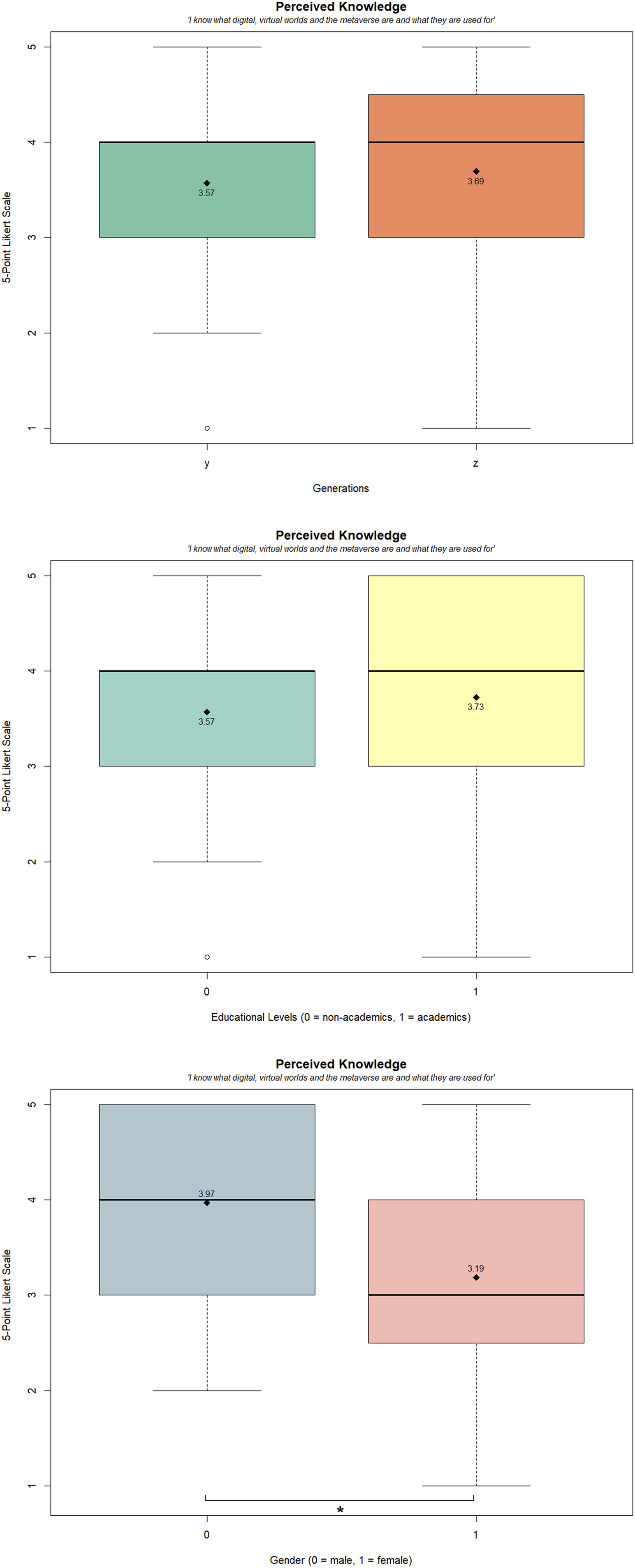
Figure 1. The boxplot diagrams show the mean values and standard deviations regarding ‘perceived knowledge about the metaverse’ for generations y and z, non-academics and academics, and females and males.
Preferred usage scenarios
In this sub-section, we look at the preferred use cases of virtual worlds and the metaverse: (1) gaming, (2) establishing social connections, (3) work and productivity, (4) entertainment, e.g., festivals and concerts, (5) sports:
As Figure 2 illustrates, with M = 4.3 (SD = 0.9) participants still consider gaming the primary activity in virtual worlds. It is followed by entertainment with M = 3.5 (SD = 1.2), social connections with M = 3.4 (SD = 1.0), work with M = 3.0 (SD = 1.1), and finally sports with M = 2.4 (SD = 1.1). This shows that despite the success of VR-games, most respondents still do not consider the body a major agent of interaction. Since Microsoft Kinect is no longer a part of the X-Box console, full-body tracking is still hardly established in consumer markets, which could explain these results. Generations Y and Z mostly agree on the importance of games, entertainment, and sports—but they significantly differ regarding (1) social connections with MY = 3.6 (SD = 0.9) and MZ = 3.2 (SD = 1.1) with t(113) = 2.184, p < .04 and (2) work with MY = 3.3 (SD = 1.1) and MZ = 2.8 (SD = 1.1) with t(113) = 2.111, p < .04 (Figure 2). Interestingly, in both cases younger participants from generation Z are more skeptical than older ones from generation Y.
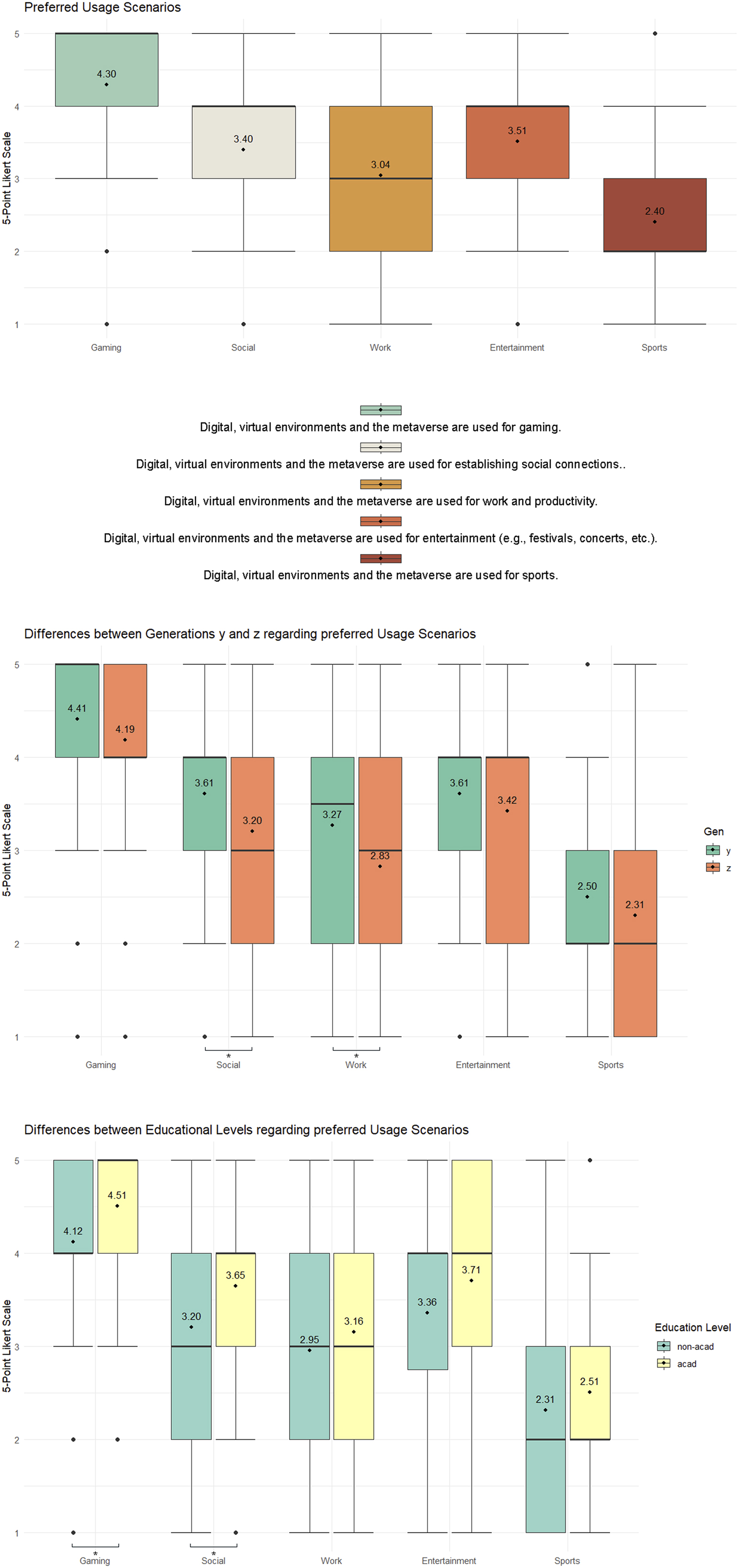
Figure 2. The first boxplot diagram shows the mean values and standard deviations for all questions regarding ‘preferred usage scenarios’ for the entire sample. The second and third boxplot diagrams show the mean values and standard deviations regarding ‘preferred usage scenarios’ for generations y and z, and non-academics and academics.
This also reflects in the correlations: age/social connections with r = .24 and age/work with r = .23, two medium-sized correlations (regarding this classification, see methods section): older participants are more likely to attribute potential to virtual worlds. This tendency can also be observed regarding the areas gaming with r = .10, entertainment with r = .12, and sports with r = .18.
Both educational groups agree on the importance of work, entertainment, and sports. However, there are significant differences regarding gaming with MNon-Acad = 4.1 (SD = 0.9) and MAcad = 4.5 (SD = 0.7) with t(113) = −2.442, p < .02 (Figure 2). Furthermore, academics with MAcad = 3.7 (SD = 0.9) in comparison to non-academics with MNon-Acad = 3.2 (SD = 1.0) rate the importance of social connections significantly higher with t(113) = −2.444, p < .02 (Figure 2). An explanation might be that many academics use virtual technologies in their daily working lives and therefore appreciate their potentials more. We did not find any significant gender related differences.
However, the greater skepticism of generation Z is also reflected in the significant difference of the overall score for the construct ‘Preferred Usage Scenarios’ with MY = 3.5 (SD = 0.7) and MZ = 3.2 (SD = 0.7) and t(113) = 2.297, p < .03 (Figure 3). The underlying construct shows how much the two generations generally see their own socio-cultural life in the metaverse.
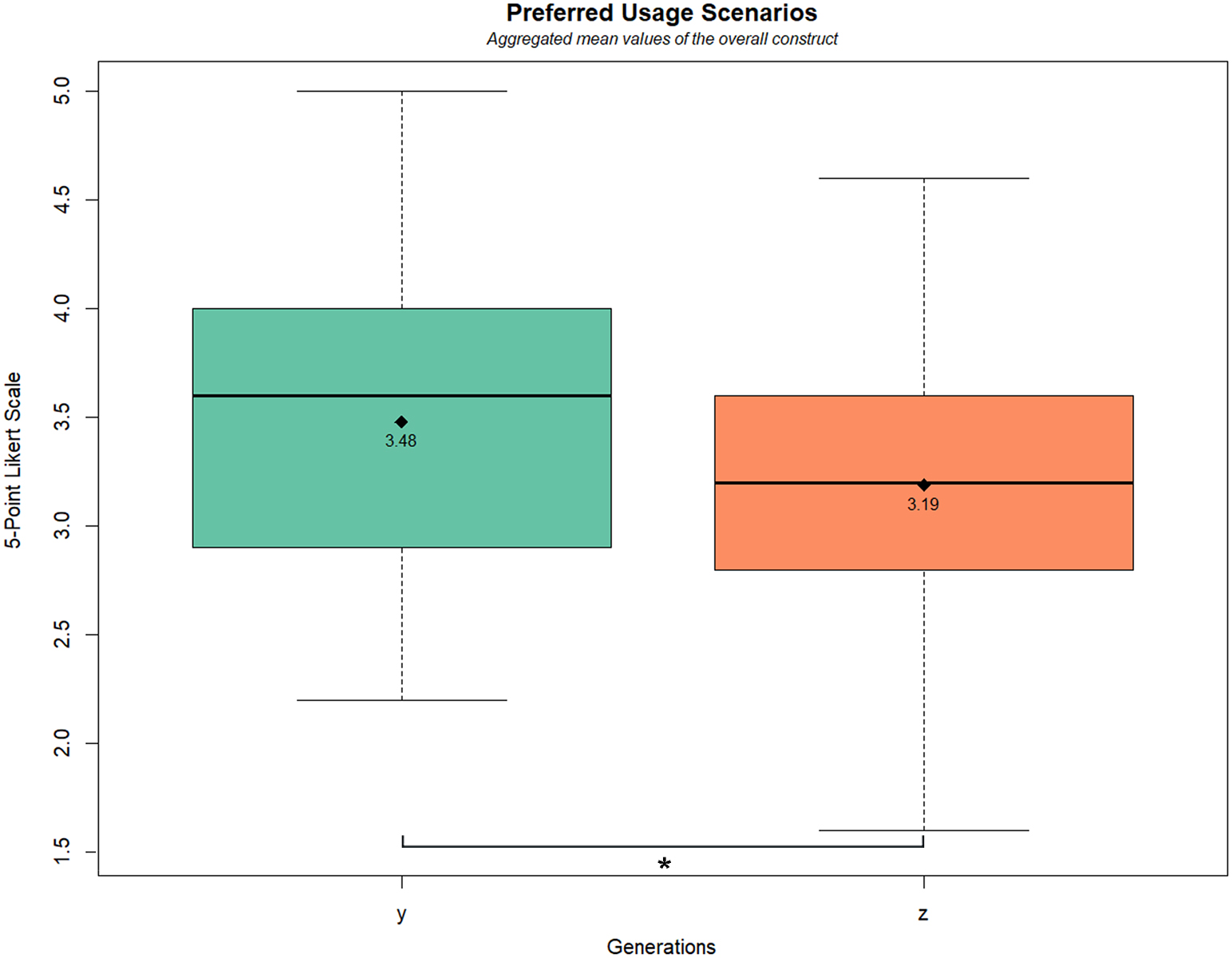
Figure 3. The boxplot diagram shows the mean values and standard deviations of the overall construct ‘preferred usage scenarios’ for generations y and z.
Interaction with avatars and embodiment
In this subsection, we look at how interactions between avatars and the real world are perceived regarding (1) limitations in comparison with the real world, (2) identification of persons behind avatars, (3) familiarity of avatars with their owners, (4) avatars and bots without human owners, (5) autonomous avatars which outlive their owners, and (6) inheritance of avatars.
With M = 3.9 (SD = 1.1) both generations are aware of the limitations that virtual worlds still have in terms of avatar interaction (Figure 4). There is no significant difference between the generations or genders (Figure 4). Likewise, there are no significant inter-educational differences with MNon-Acad = 3.9 (SD = 1.0) and MAcad = 3.8 (SD = 1.2) (Figure 4).
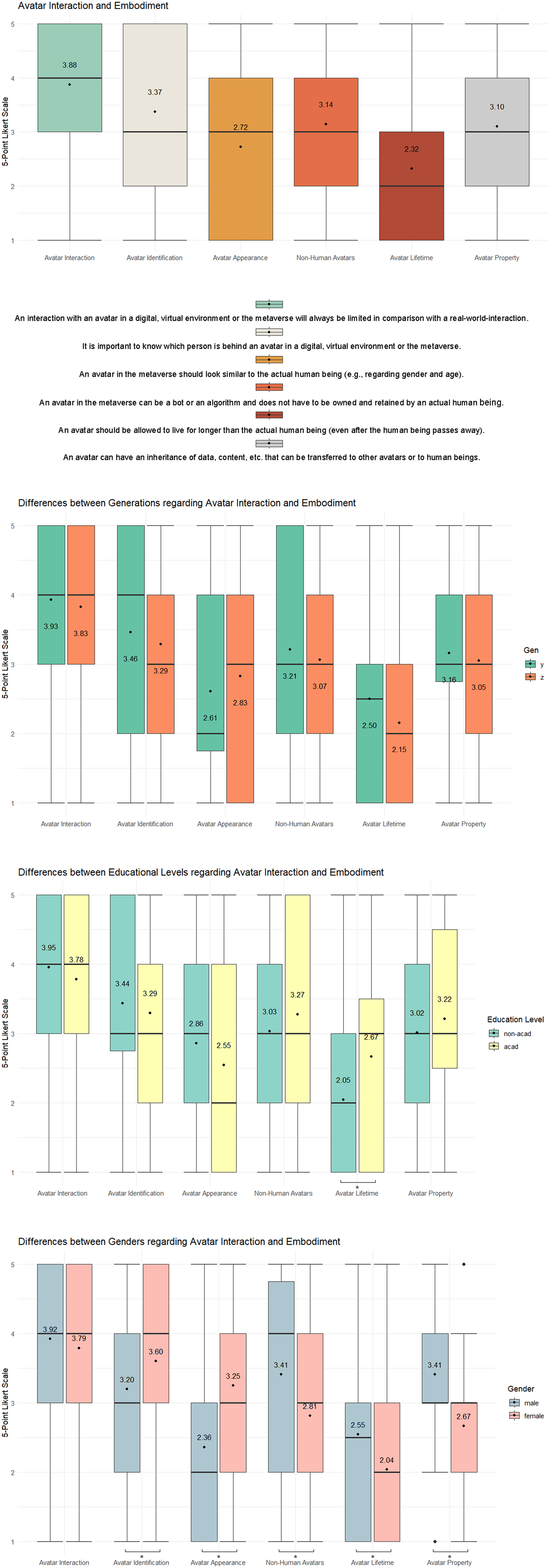
Figure 4. The first boxplot diagram shows the mean values and standard deviations for all questions regarding ‘avatar interaction and embodiment’ for the entire sample. The second, third, and fourth boxplot diagrams show the mean values and standard deviations regarding ‘avatar interaction and embodiment’ for generations y and z, non-academics and academics, and females and males.
With M = 3.4 (SD = 1.3) more than 50% of the respondents think that the ‘identification of persons behind avatars’ is important (Figure 4). Although the younger generation is somewhat more generous in this regard with MZ = 3.3 (SD = 1.2) versus MY = 3.5 (SD = 1.3), the difference is not significant (Figure 4). Similarly, no significant educational differences were found (Figure 4). However, with MMALE = 3.2 (SD = 1.3) and MFEMALE = 3.6 (SD = 1.3), females stress the importance of an ‘identification of persons behind avatars’ more. With t(112) = −1.684, p < .05 this difference is significant (Figure 4).
With M = 2.7 (SD = 1.4) the ‘familiarity of avatars with their owners’ (we specified: e.g., regarding gender and age) does not seem a high priority for both generations and educational groups (Figure 4). Probably, they remember the freedom of avatar design in most games. Also, there is no significant difference between the generations or educational groups (Figure 4). Again, females with MFEMALE = 3.3 (SD = 1.4) rate the importance of a ‘familiarity of avatars with their owners’ higher than males with MMALE = 2.4 (SD = 1.4). With t(112) = −2.993, p < .01 this difference is highly significant (Figure 4). These results indicate that women care more about knowing the identity of persons they are interacting with, which might be explained by the fact that women are more likely to experience sexual assault and coercion.
The item ‘avatars and bots without human owners’ despite its controversial topic, was perceived neutral with M = 3.1 (SD = 1.4) (Figure 4). It would be interesting to see how this view adapts with the rise of agents based on artificial intelligence. However, the neutral attitude is shared by both generations and both educational groups with no significant difference (Figure 4). Interestingly, males with MMALE = 3.4 (SD = 1.3) accept bots and non-human avatars significantly more than females with MFEMALE = 2.8 (SD = 1.3) and t(112) = 2.346, p < .02 (Figure 4). This is consistent with the general assumption that men are often more risk-taking.
The somewhat weird idea of ‘autonomous avatars outliving their owners’—a topic related to the inheritance of digital data on social media platforms—is generally rejected with M = 2.3 (SD = 1.4) (Figure 4). However, in this case there is a marginally significant difference between the generations with MY = 2.5 (SD = 1.5) and MZ = 2.2 (SD = 1.2), resulting in t(113) = 1.353, p < .09 (Figure 4). Here, the heightened sensitivity of generation Z regarding data integrity might have come into play. Likewise, females responded more skeptical to this idea with MMALE = 2.6 (SD = 1.5) and MFEMALE = 2.0 (SD = 1.2), and a significant difference with t(112) = 1.957, p < .05 (Figure 4). Moreover, with MNon-Acad = 2.0 (SD = 1.2) and MAcad = 2.7 (SD = 1.5) and t(113) = −2.456, p < .02, academics felt significantly less uncomfortable with this idea (Figure 4).
Another controversial topic is the ‘inheritance of avatars’. As a well-equipped character in a game can be worth hundreds or even thousands of dollars, this topic is rather concrete. Again, the two generations do not have strong feelings in either direction with M = 3.1 (SD = 1.3) and there are no significant intergenerational or inter-educational differences (Figure 4). Again, with MMALE = 3.4 (SD = 1.2) and MFEMALE = 2.7 (SD = 1.3), males accept this notion significantly more than females with t(112) = 3.152, p < .01 (Figure 4).
As outlined in the methods section, due to the low Cronbach’s Alpha value we did not analyze any differences with regards to the overall construct ‘Interaction with Avatars and Embodiment’.
Perceived problems and challenges
In this subsection, we investigate the perceived challenges of virtual worlds: (1) discomfort (“cybersickness”), (2) exclusion by others, (3) exclusion by content, (4) psychological harm or harassment, (5) physical harm by accidents, and (6) negative real-life effects.
With M = 3.0 (SD = 1.4) participants take a neutral standpoint regarding ‘discomfort’ or cybersickness (Figure 5). Also, there is no significant difference between the generations or genders (Figure 5). However, there is a significant difference between the educational groups with MNon-Acad = 2.8 (SD = 1.4) and MAcad = 3.3 (SD = 1.3), with t(113) = −2.109, p < .04 (Figure 5). Nevertheless, this issue might become obsolete with future improved VR-headsets.
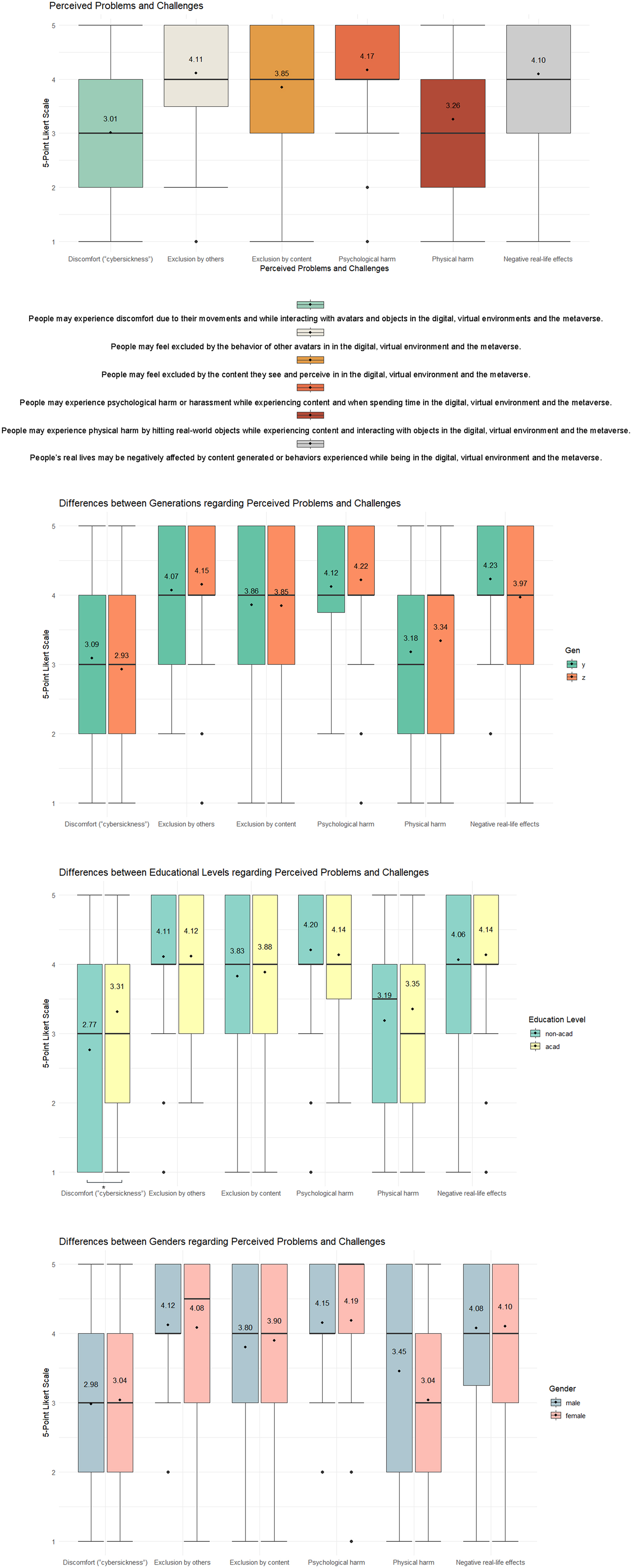
Figure 5. The first boxplot diagram shows the mean values and standard deviations for all questions regarding ‘perceived problems and challenges’ for the entire sample. The second, third, and fourth boxplot diagrams show the mean values and standard deviations regarding ‘perceived problems and challenges’ for generations y and z, non-academics and academics, and females and males.
With M = 4.1 (SD = 1.0) the ‘exclusion by others’ is perceived a much greater threat than technology (Figure 5). Both generations, genders, and educational groups are aligned in this perception as there is no significant difference between them (Figure 5).
In contrast to persons, the ‘content’ of virtual worlds is perceived as less problematic with M = 3.9 (SD = 1.1) (Figure 5). Nevertheless, this score reflects an intergenerational as well as inter-educational agreement with no significant differences (Figure 5).
Regarding the threat of ‘psychological harm or harassment’, the two generations again are aligned with an overall mean of M = 4.2 (SD = 1.0) (Figure 5). This is the highest mean value regarding threats and challenges, and there is no significant difference (Figure 5). The same applies for the genders, and the educational groups (Figure 5).
Interestingly, worries about being harassed (e.g., being bullied, sexually coerced etc.) correlate with the item ‘identification of persons behind avatars’ with r = .34 and p < .001, indicating a coherence between worries and the potential to identify the persons behind such harassments. In comparison, ‘physical harm’—just like ‘physiological discomfort’—is considered a smaller threat with M = 3.3 (SD = 1.4) (Figure 5). Again, there is no significant difference between generations, educational groups, or genders (Figure 5).
The final item focuses on ‘negative real-life effects’. Here we thought about addiction or the loss of real-world social relations. Indeed, this is perceived as the second highest risk with M = 4.1 (SD = 1.0) (Figure 5). There is a slight difference between the generations, with MY = 4.2 (SD = 0.9) and MZ = 4.0 (SD = 1.0)—however, with t(113) = 1.473, p < .15 (Figure 5) it is not significant. The younger generation Z, who grew up with digital technologies, may have a slightly reduced fear of losing traction with the real-world. The educational groups are aligned with MNon-Acad = 4.0 (SD = 1.0) and MAcad = 4.1 (SD = 1.0) (Figure 5) as well as the genders with MMALE = 4.1 (SD = 1.0) and MFEMALE = 4.1 (SD = 1.0) (Figure 5).
Regarding the analysis of mean differences of the overall construct ‘Perceived Challenges of Virtual Worlds’, with MY = 3.8 (SD = 0.7) and MZ = 3.7 (SD = 0.9), MNon-Acad = 3.7 (SD = 0.8) and MAcad = 3.8 (SD = 0.7), and MMALE = 3.8 (SD = 0.7) and MFEMALE = 3.7 (SD = 0.9) there were no significant differences. Generations, educational groups, and genders align regarding perceived challenges with a tendency to see rather problems than solutions.
Personal worries regarding virtual worlds
In this subsection, we expand the analysis of how potential challenges of virtual worlds are perceived by adding a personal dimension: all assertions start with “I feel worried about”. Topics are (1) content shared and created, (2) data on emotional responses, (3) data of physical behavior, (4) data on cognitive behavior, (5) data on the surrounding environment, and finally (6) AI mimicking the own behavior.
With M = 3.3 (SD = 1.2) participants are only mildly worried about ‘content shared and created’ (Figure 6). Despite a high awareness of data privacy in Germany, laws like GDPR seem to inspire confidence. This goes for both generations, both educational groups, and both genders, as there is no significant difference (Figure 6).
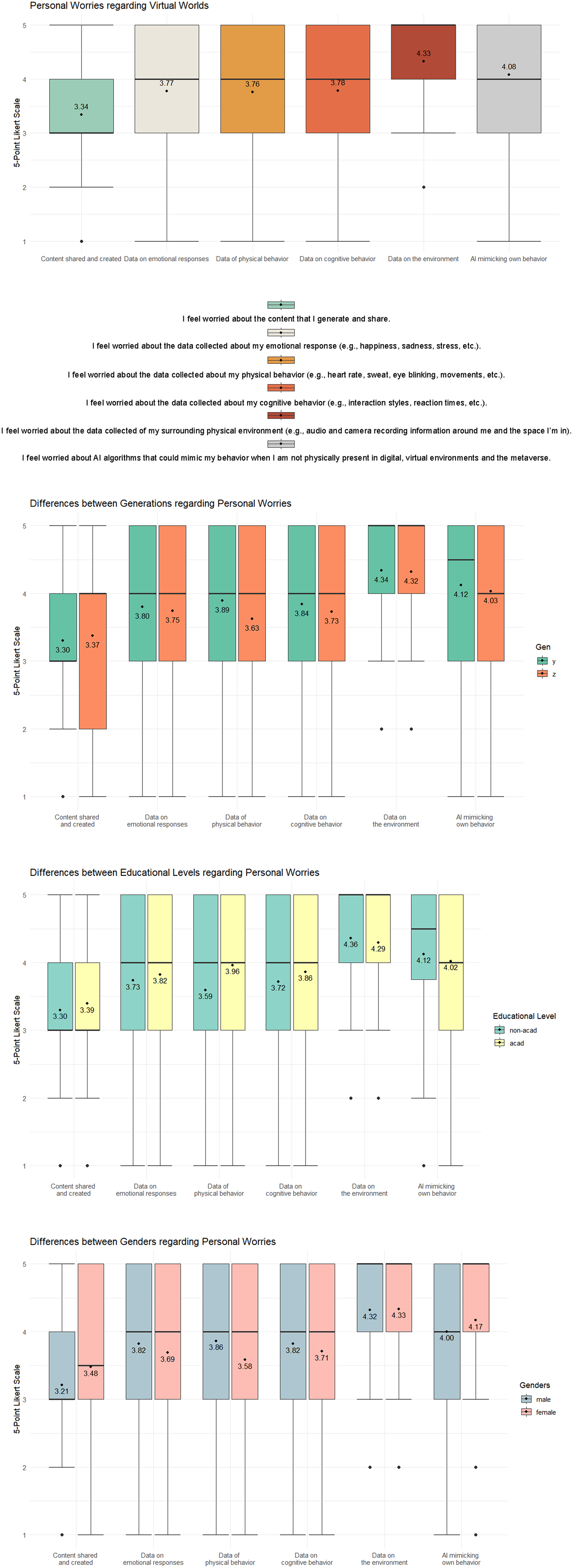
Figure 6. The first boxplot diagram shows the mean values and standard deviations for all questions regarding ‘personal worries’ for the entire sample. The second, third, and fourth boxplot diagrams show the mean values and standard deviations regarding ‘personal worries’ for generations y and z, non-academics and academics, and females and males.
Since emotions are a much more private matter it is surprising that collecting ‘data on emotional responses’ only reaches M = 3.8 (SD = 1.1) (Figure 6) with no significant differences between the generations, educational groups, or genders (Figure 6). Indeed, options like eye tracking or heartrate measurement could increase the immersion of users in games and other applications—so these positive aspects might have played a role in this neutral attitude.
Moving from affects to cognition, we asked about worries regarding the collection of ‘data on cognitive behavior’. With M = 3.8 (SD = 1.2) (Figure 6) this question closes a row of three with identical means and no intergenerational, nor inter-educational, or gender-related differences (Figure 6).
The next item “hit the spot” regarding the common fear of being spied on. With M = 4.3 (SD = 0.9) the collection of ‘data on the surrounding environment’ is the greatest of the six worries (Figure 6). A multitude of scandals from permanently recording Echo devices to the Ring doorbell being used to spy on customers (Farid, 2023) are good reasons for this skepticism. Again, the values for both generations—including the low SD—are almost identical and thus do not differ significantly (Figure 6). The same applies for the different educational groups and gender groups (Figure 6).
The last potential worry is ‘AI mimicking one’s own behavior’ when the user is not present in the virtual world. With M = 4.1 (SD = 1.1) (Figure 6) this is the second greatest of the six worries, which again is equally shared by both generations, educational groups, and genders with no significant differences (Figure 6).
Considering the mean values MY = 3.3 (SD = 1.1) and MZ = 3.4 (SD = 1.3), MNon-Acad = 3.8 (SD = 0.9) and MAcad = 3.9 (SD = 0.8), and MMALE = 3.9 (SD = 0.8) and MFEMALE = 3.8 (SD = 0.9) of the overall construct ‘personal worries regarding virtual worlds’, generations y and z, non-academics and academics, as well as females and males share the same worries and favor a cautious use of the new technology.
Solutions for safeguarding virtual worlds
After two sub-sections on challenges, problems, and worries, this subsection looks at solutions. We asked: “To guarantee safety and ethical behavior in digital, virtual environments and the metaverse, please rate which system you think would be most appropriate.” The proposed decision-making systems were (1) AI-based case-to-case, (2) AI-based case-to-case with human-in-the-loop, (3) third-party evaluators and safety officers, and (4) digital filters, shield systems etc.
This might be the most interesting part of this section, as the respondents had to come up with solutions to all the problems and worries elaborated in the previous parts. With M = 3.0 (SD = 1.2) an ‘AI-based case-to-case’ decision-making system is in overall considered neutral (Figure 7). However, there is a significant difference between the two generations with MY = 3.2 (SD = 1.3) and MZ = 2.8 (SD = 1.1) with t(113) = 2.005, p < .05 (Figure 7). This shows that the younger generation Z is more skeptical regarding a system purely based on AI and thus confirms the observation from the subsection on usage scenarios. This increase with age is also reflected by the positive correlation between age and the preference for such a system with r = .15.
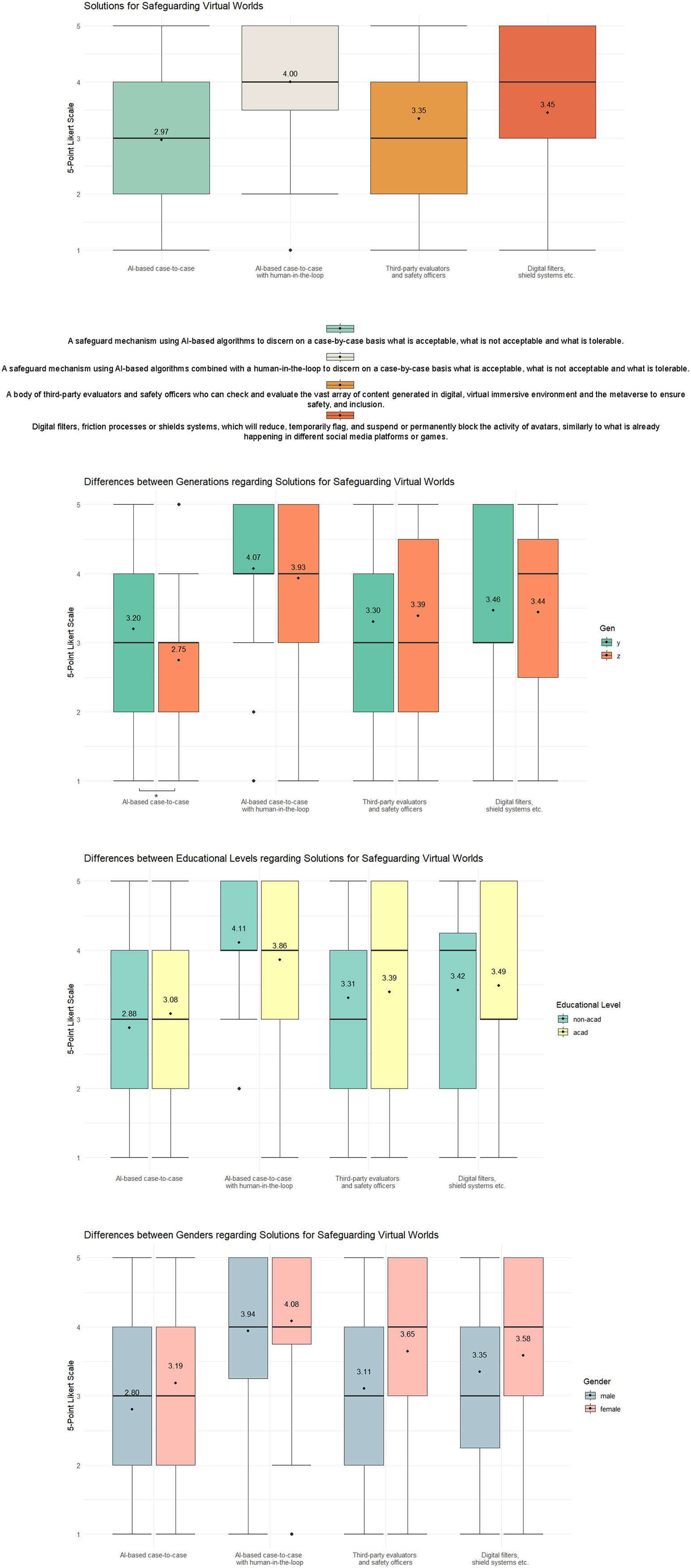
Figure 7. The first boxplot diagram shows the mean values and standard deviations for all questions regarding ‘solutions for safeguarding virtual worlds’ for the entire sample. The second, third, and fourth boxplot diagrams show the mean values and standard deviations regarding ‘solutions for safeguarding virtual worlds’ for generations y and z, non-academics and academics, and females and males.
A decision-making system using ‘AI-based case-to-case with human-in-the-loop’ is clearly preferred with M = 4.0 (SD = 1.0) (Figure 7). While again generation Z is more skeptical with MZ = 3.9 (SD = 0.9) versus MY = 4.1 (SD = 1.0), this difference is not significant (Figure 7). Likewise, there are no significant differences between the educational groups, or the genders (Figure 7).
At least for the younger generations, large controlling bodies do not seem attractive anymore: while with M = 3.3 (SD = 1.3) the option of ‘Third-party evaluators and safety officers’ was preferred to the AI-only alternative, it still is far less appreciated than the solution discussed above (Figure 7). There are no significant differences between the generations, the educational groups, or the genders (Figure 7).
With M = 3.5 (SD = 1.3) the option of using ‘Digital filters, shield systems etc.’, the common practice in many social media and gaming platforms, is the second most popular (Figure 7). Again, there are no significant differences between generations, education groups, or the genders (Figure 7).
Regarding the analysis of mean differences of the overall construct ‘Solutions for Safeguarding Virtual Worlds’, with MY = 3.5 (SD = 0.9) and MZ = 3.4 (SD = 0.8) and MNon-Acad = 3.4 (SD = 0.7) and MAcad = 3.5 (SD = 0.9), both generations and educational groups rated the importance of solutions for safeguarding the metaverse equally. However, females stressed the importance of safeguarding measures significantly more than men, with MMALE = 3.3 (SD = 0.8) and MFEMALE = 3.6 (SD = 0.8) and t(112) = −2.119, p < .04 (Figure 8). Apart from the fact that men are considered more risk taking, this result reflects the general higher caution of females interacting as entities in virtual worlds and aligns with the results regarding avatar interaction.
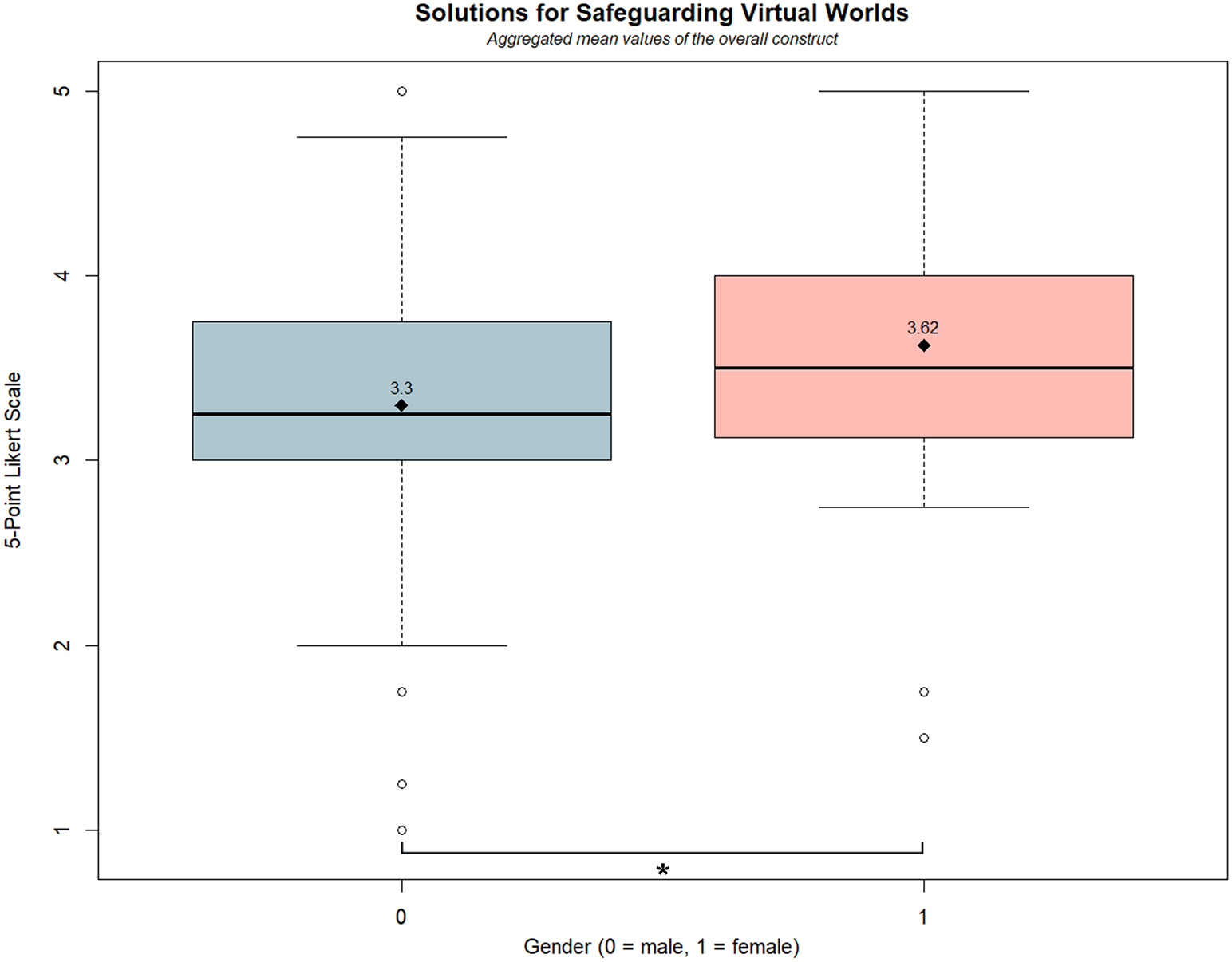
Figure 8. The boxplot diagram shows the mean values and standard deviations of the overall construct ‘solutions for safeguarding virtual worlds’ for females and males.
Institutions to drive the safeguarding
In this subsection we explore which institution is perceived as most suitable to put safeguarding solution into practice. The alternatives were: (1) technology businesses, (2) independent research institutes, (3) policymakers and standardization organizations, (4) states or countries, and (5) academic institutions.
With the scandals mentioned above and a background of frequent compensation payments from legal disputes it is not surprising that ‘Technology businesses’ with M = 2.9 (SD = 1.5) only reach a neutral ranking (Figure 9). This is identical for both generations and educational groups. However, there is a marginally significant difference between females and males with MMALE = 2.7 (SD = 1.5) and MFEMALE = 3.2 (SD = 1.4) and t(112) = −1.812, p < .1 (Figure 9).
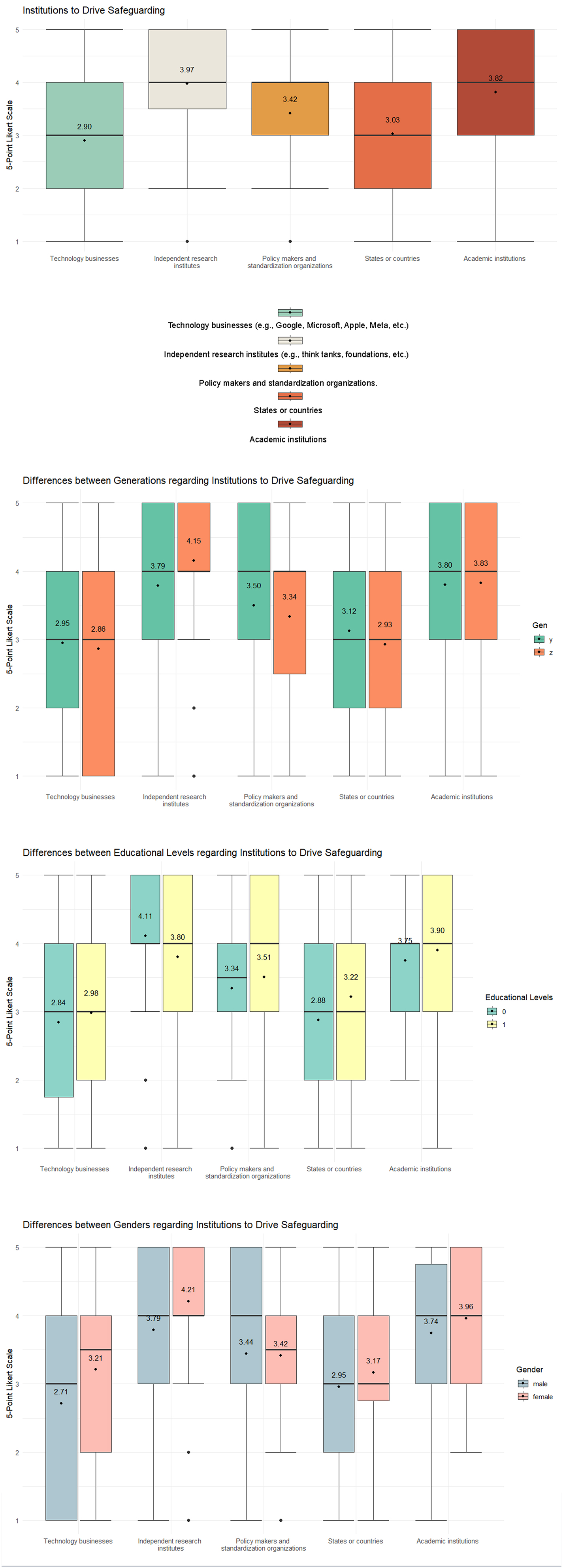
Figure 9. The first boxplot diagram shows the mean values and standard deviations for all questions regarding ‘institutions to drive safeguarding’ for the entire sample. The second, third, and fourth boxplot diagrams show the mean values and standard deviations regarding ‘institutions to drive safeguarding’ for generations y and z, non-academics and academics, and females and males.
‘Independent research institutes’ are much more appreciated: with M = 4.0 (SD = 1.2) this is the favorite option (Figure 9). However, with MZ = 4.2 (SD = 1.0) the young respondents from generation Z like it even more than respondents from generation Y with MY = 3.8 (SD = 1.3). This is a marginally significant difference with t(113) = −1.723, p < .1 (Figure 9). Moreover, there is a significant difference between females and males with MMALE = 3.8 (SD = 1.3) and MFEMALE = 4.2 (SD = 1.0) and t(112) = −1.948, p = .5 (Figure 9).
Not surprisingly, with M = 3.4 (SD = 1.3), ‘Policymakers and standardization organizations’ are more trusted than the technology companies, but considerably less than independent research institutions (Figure 9). There is no significant difference between the generations, educational groups, or genders (Figure 9).
With M = 3.0 (SD = 1.3) the belief in ‘States or countries’ is only slightly higher than the trust in technology companies, leaving them with a neutral rating (Figure 9). Again, there is no significant difference between the generations, educational groups, or genders (Figure 9).
The ‘Academic institutions’—in this case the established universities rather than the independent ones—are still second in preference with M = 3.8 (SD = 1.0) (Figure 9). Again, there are no significant intergenerational, inter-educational, or gender-related differences (Figure 9). Accordingly, it looks like the respondents, of which 44% have an academic background themselves, believe in the power of research institutions—although they prefer the independent ones.
Regarding the analysis of mean differences of the overall construct ‘Institutions to Drive Safeguarding, with MY = 3.4 (SD = 0.9) and MZ = 3.4 (SD = 0.8) and MNon-Acad = 3.4 (SD = 0.7) and MAcad = 3.5 (SD = 1.0), both generations and educational groups are aligned regarding different safeguarding institutions. However, with MMALE = 3.3 (SD = 0.9) and MFEMALE = 3.6 (SD = 0.7) and t(112) = −1.687, p < .1, there is a marginally significant difference between females and males. Females generally seem to see a greater responsibility in institutions.
Conclusion
In this study we investigated the perceptions of 115 younger people from the generations Y and Z and analyzed their perceptions and expectations regarding their educational background and their gender. The study highlighted the following areas: perceived knowledge, preferred usage scenarios, interaction with avatars and embodiment, perceived problems and challenges, personal worries, solutions for safeguarding, and institutions to drive the safeguarding process.
Perceived Knowledge. Both generations have almost identical slightly positive perceptions regarding their knowledge. When looking at gender, male respondents perceive themselves as significantly more knowledgeable than females. In general, men tend to rate their own abilities higher than women. While women are predominantly more cautious about their own abilities, men often overestimate themselves. With regard to their own cognitive abilities, for example, this has been confirmed many times in the literature (Hogan, 1978; Bennett, 2019). Moreover, there is the common notion that men are more attracted to technology than women.
Preferred usage scenarios. Most participants consider ‘gaming’ the primary activity in virtual worlds, followed by ‘entertainment’ and ‘social connections’. ‘Work’ and ‘sports’ are hardly seen as promising areas. While both generations mostly agree, there are significant differences regarding ‘social connections’ and ‘work’: in both cases the younger participants from generation Z are more skeptical than the older ones from generation Y. Regarding the inter-educational perspective, academics rate the importance of ‘social connections’ significantly higher than non-academics. A possible explanation is that academics use virtual technologies more often in their working lives and therefore not only appreciate their benefits more but also rate the necessity and importance higher due to their facilitative characteristics.
Interaction with Avatars and Embodiment. The generations are mostly aligned regarding ‘limitation in comparison with the real world’, ‘identification of persons behind avatars’, ‘familiarity of avatars with their owners’, ‘avatars and bots without human owners’, and ‘inheritance of avatars’. The only area they differ is ‘autonomous avatars outliving their owners’, where again generations Z is more critical. We also found significant gender-related differences regarding ‘identification of persons behind avatars’: while men consider this unimportant, the significantly higher value for women implies that they are keen on knowing who is behind an avatar. This also reflects in ‘familiarity of avatars with their owners’. A possible explanation is the fact that women are more likely to experience sexual assault or coercion. This is an important finding for designers of virtual worlds to include “safe spaces” and appropriate sensitive measures to protect women who might feel unsafe. Finally, academics felt significantly less uncomfortable with the idea of ‘autonomous avatars outlasting their owner’s death’. One possible explanation could be a higher prioritization of one’s own self-realization and the desire to leave something behind for posterity that will last even after one’s own death.
Perceived Problems and Challenges. The respondents of different age groups mostly perceive threats and challenges similarly. ‘Psychological harm or harassment’ is the greatest, closely followed by ‘exclusion by others’. Since people who stress the importance for an ‘identification of persons behind avatars’ also worry more about ‘psychological harm or harassment’, there is a strong indication for measures and policies addressing these issues, particularly for female users. Regarding technology adoption, this is an important fact for metaverse developers and designers in order to create systems for reporting.
Personal Worries Regarding Virtual Worlds. Respondents are only mildly worried about ‘content shared and created’ and share mild worries regarding ‘data on emotional responses’, ‘data on physical behavior’ and ‘data on cognitive behavior’. In comparison, the fear of “being spied on” is much more prevalent, directly followed by the worry of ‘AI mimicking one’s own behavior’.
Solutions for Safeguarding Virtual Worlds. When it comes to solutions to the challenges and worries, both generations clearly favor a decision-making system using ‘AI-based case-to-case with human-in-the-loop’ over purely AI-based solutions. Especially the younger generation Z is significantly more skeptical regarding an AI-only solution. Solutions primarily relying on humans like ‘Digital filters, shield systems etc.’ or ‘Third-party evaluators and safety officers’ are considered inferior.
Institutions to Drive Safeguarding. Both generations prefer independent research institutions, with generation Z preferring this option even more. Other options like technology companies, political entities or policymakers and standardization organizations rank considerably lower—only normal universities are also appreciated.
To conclude, in many areas, respondents from the generations Y and Z are aligned in their perception of virtual worlds and the metaverse—both regarding challenges and potentials. It is a major finding that in the cases where they differ, the younger generation Z is always more skeptical than generation Y. Potentially this is due to its heightened sensitivity regarding data integrity, personal wellbeing, and sustainability.
Another major finding are the gender-related differences regarding the importance of interaction with avatars and embodiment, and safeguarding measures. Indeed, sexual harassment of female players is a well-known phenomenon in online video games and massively multiplayer games (Tang et al., 2019), where—unlike in social media—players are also present as embodied spatial entities. Our findings underscore the value of specifically designed measures for reporting and safeguarding one’s own personality. This is particularly important, as the metaverse will influence numerous areas of real life (e.g., work, administration, community life) in addition to its currently predominating entertaining character. At the same time, developers and designers should avoid “overruling” users with smart solutions and evoke “technology paternalism” (Rochi et al., 2024).
Limitations and future work
Although 23 respondents were from abroad (e.g., five persons from Turkey, two from France, and two from Poland), 92 respondents had a German cultural background. Thus, it is up to future research to determine if the results gained in this work are universal. First analyses over the subsets German/abroad did not yield big differences. Indeed, young academics might be culturally alike due to shared experiences in higher education, so future studies might highlight different cultural groups.
A central question is, where Generation Z’s raised skepticism comes from. Beside a general heightened sensitivity, another reason could be so-called inheritance effects, as they are already known from other disciplines such as political science (Angus et al. , 1954). For example, there is evidence that younger people’s cultural opinions are not yet solidified, and many have not gathered enough life experience to develop their own political views. A parental socialization is the consequence (Achen, 2002). It would be interesting to determine whether similar attitudes prevail in Generation X and whether these have been passed on to Generation Z.
Data availability statement
The raw data supporting the conclusion of this article will be made available by the authors, without undue reservation.
Ethics statement
The studies involving humans were approved by Offenburg University Ethical Committee. The studies were conducted in accordance with the local legislation and institutional requirements. The participants provided their written informed consent to participate in this study.
Author contributions
OK: Supervision, Writing–original draft, Writing–review and editing. MZ: Conceptualization, Writing–review and editing. BS: Investigation, Data curation, Formal Analysis, Methodology, Writing–review and editing.
Funding
The author(s) declare that financial support was received for the research, authorship, and/or publication of this article. This work was supported by Offenburg University Open Access Publications Fund and the Affective and Cognitive Institute (ACI).
Acknowledgments
This work was supported by the following Master’s students: Alexandra Berger, Thomas Huck, and Jennifer Pana.
Conflict of interest
The authors declare that the research was conducted in the absence of any commercial or financial relationships that could be construed as a potential conflict of interest.
Publisher’s note
All claims expressed in this article are solely those of the authors and do not necessarily represent those of their affiliated organizations, or those of the publisher, the editors and the reviewers. Any product that may be evaluated in this article, or claim that may be made by its manufacturer, is not guaranteed or endorsed by the publisher.
References
Achen, C. H. (2002). Parental socialization and rational party identification. Polit. Behav. 24, 151–170. doi:10.1023/a:1021278208671
Alfaisal, R., Hashim, H., and Azizan, U. H. (2022). Metaverse system adoption in education: a systematic literature review. J. Comput. Educ. 11, 259–303. doi:10.1007/s40692-022-00256-6
Angus, C., Gerald, G., and Warren, E. (1954). Miller, the voter decides, evanston/white plains. Cambridge, UK: Cambridge University Press. doi:10.3390/electronics11030336
Bennett, B. (2019). Technology, ageing and human rights: challenges for an ageing world. Int. J. Law Psychiatry 66, 101449. doi:10.1016/j.ijlp.2019.101449
Buhalis, D., and Karatay, N. (2022). “Mixed reality (MR) for generation Z in cultural heritage tourism towards metaverse,” in Information and communication technologies in tourism 2022 (S. 16–27). Editors J. L. Stienmetz, B. Ferrer-Rosell, and D. Massimo (Springer International Publishing). Berlin, Germany, doi:10.1007/978-3-030-94751-4_2
Buhalis, D., Leung, D., and Lin, M. (2023). Metaverse as a disruptive technology revolutionising tourism management and marketing. Tour. Manag. 97, 104724. doi:10.1016/j.tourman.2023.104724
Chen, B., Wang, Y., and Wang, L. (2022). The effects of virtual reality-assisted language learning: a meta-analysis. Sustainability 14 (6), 3147. doi:10.3390/su14063147
Cho, J., tom Dieck, M. C., and Jung, T. (2023). “What is the metaverse? Challenges, opportunities, definition, and future research directions,” in Extended reality and metaverse (S. 3–26). Editors T. Jung, M. C. tom Dieck, and S. M. Correia Loureiro (Springer International Publishing). Berlin, Germany. doi:10.1007/978-3-031-25390-4_1
Cohen, J. (1988). Statistical power analysis for the behavioral sciences (2nd ed.). New York, NY: Routledge. doi:10.4324/9780203771587
Cronbach, L. J. (1951). Coefficient alpha and the internal structure of tests. Psychometrika 16 (3), 297–334. doi:10.1007/BF02310555
Curran, V. R., Xu, X., Aydin, M. Y., and Meruvia-Pastor, O. (2022). Use of extended reality in medical education: an integrative review. Med. Sci. Educ. 33 (1), 275–286. doi:10.1007/s40670-022-01698-4
De Felice, F., Petrillo, A., Iovine, G., Salzano, C., and Baffo, I. (2023). How does the metaverse shape education? A systematic literature review. Appl. Sci. 13 (9), 5682. doi:10.3390/app13095682
Díaz, J. E. M. (2020). Virtual world as a complement to hybrid and mobile learning. Int. J. Emerg. Technol. Learn. (iJET) 15 (22), 267. doi:10.3991/ijet.v15i22.14393
Dionisio, J. D. N., Iii, W. G. B., and Gilbert, R. (2013). 3D Virtual worlds and the metaverse: current status and future possibilities. ACM Comput. Surv. 45 (3), 1–38. doi:10.1145/2480741.2480751
Duan, H., Li, J., Fan, S., Lin, Z., Wu, X., and Cai, W. (2021). “Metaverse for social good: a university campus prototype,” in Proceedings of the 29th ACM International Conference on Multimedia, Virtual Event, China, October 2021, 153–161. doi:10.1145/3474085.3479238
Dwivedi, Y. K., Hughes, L., Baabdullah, A. M., Ribeiro-Navarrete, S., Giannakis, M., Al-Debei, M. M., et al. (2022). Metaverse beyond the hype: multidisciplinary perspectives on emerging challenges, opportunities, and agenda for research, practice and policy. Int. J. Inf. Manag. 66, 102542. doi:10.1016/j.ijinfomgt.2022.102542
Dwivedi, Y. K., Hughes, L., Wang, Y., Alalwan, A. A., Ahn, S. J., Balakrishnan, J., et al. (2023). Metaverse marketing: how the metaverse will shape the future of consumer research and practice. Psychol. Mark. 40 (4), 750–776. doi:10.1002/mar.21767
Dwivedi, Y. K., Kshetri, N., Hughes, L., Rana, N. P., Baabdullah, A. M., Kar, A. K., et al. (2023). Exploring the darkverse: a multi-perspective analysis of the negative societal impacts of the metaverse. Inf. Syst. Front. 25, 2071–2114. doi:10.1007/s10796-023-10400-x
Fenu, C., and Pittarello, F. (2018). Svevo tour: the design and the experimentation of an augmented reality application for engaging visitors of a literary museum. Int. J. Human-Computer Stud. 114, 20–35. doi:10.1016/j.ijhcs.2018.01.009
Ferreira, J. M. M., and Qureshi, Z. I. (2020). “Use of XR technologies to bridge the gap between higher education and continuing education,” in 2020 IEEE Global Engineering Education Conference (EDUCON), Porto, Portugal, April 2020, 913–918. doi:10.1109/EDUCON45650.2020.9125346
Forbes (2022). Metaverse vs multiverse: how to tell apart the ‘parallel universe’ concepts we can’t stop talking about. Accessed 7 February 2022, https://www.forbes.com/sites/jamiecartereurope/2022/02/07/metaverse-vs-multiverse-how-to-tell-apart-the-two-mind-bending-concepts-we-cant-stop-talking-about/.
Freeman, G., and Maloney, D. (2021). Body, avatar, and me: the presentation and perception of self in social virtual reality. Proc. ACM Human-Computer Interact. 4 (CSCW3), 239:1–27. doi:10.1145/3432938
Gamito, P., Oliveira, J., Morais, D., Coelho, C., Santos, N., Alves, C., et al. (2019). Cognitive stimulation of elderly individuals with instrumental virtual reality-based activities of daily life: pre-post treatment study. Cyberpsychology, Behav. Soc. Netw. 22 (1), 69–75. doi:10.1089/cyber.2017.0679
Giang Barrera, K., and Shah, D. (2023). Marketing in the Metaverse: conceptual understanding, framework, and research agenda. J. Bus. Res. 155, 113420. doi:10.1016/j.jbusres.2022.113420
Gignac, G. E., and Szodorai, E. T. (2016). Effect size guidelines for individual differences researchers. Personal and Indivi Differe. 102, 74–78. doi:10.1016/j.paid.2016.06.069
Goldgehn, L. A. (2004). Generation Who, What, Y? What you need to know about generation Y. Int. J. Educ. Adv. 5 (1), 24–34. (HENRY STEWART PUBLICATIONS ). doi:10.1057/palgrave.ijea.2140202
Gonzalez-Moreno, M., Andrade-Pino, P., Monfort-Vinuesa, C., Piñas-Mesa, A., and Rincon, E. (2023). Improving humanization through metaverse-related technologies: a systematic review. Electronics 12 (7), 1727. doi:10.3390/electronics12071727
Görlich, D. (2022). Societal XR—a vision paper. ParadigmPlus 3 (2), 1–10. doi:10.55969/paradigmplus.v3n2a1
Hogan, H. W. (1978). IQ self-estimates of males and females. J. Soc. Psychol. 106 (1), 137–138. doi:10.1080/00224545.1978.9924160
Israel, K., Buchweitz, L., Tscheulin, D. K., Zerres, C., and Korn, O. (2020). “Captivating product experiences: how virtual reality creates flow and thereby optimize product presentations,” in HCI in business, Government and organizations (S. 354–368). Editors F. F.-H. Nah, and K. Siau (Hrsg (Springer International Publishing). Berlin, Germany, doi:10.1007/978-3-030-50341-3_28
Israel, K., Zerres, C., Tscheulin, D. K., Buchweitz, L., and Korn, O. (2019). “Presenting your products in virtual reality: do not underestimate cybersickness,” in HCI in business, government and organizations. ECommerce and consumer behavior. Editors F. F.-H. Nah, and K. Siau (Springer International Publishing). Berlin, Germany, 206–224. doi:10.1007/978-3-030-22335-9_14
Jicol, C., Wan, C. H., Doling, B., Illingworth, C. H., Yoon, J., Headey, C., et al. (2021). “Effects of emotion and agency on presence in virtual reality,” in Proceedings of the 2021 CHI Conference on Human Factors in Computing Systems, Yokohama, Japan, May 2021, 1–13. doi:10.1145/3411764.3445588
Katz, S. (2017). Generation X. A critical sociological perspective. Generations J. Am. Soc. Aging 41 (3), 12–19. https://www.jstor.org/stable/26556295.
Kilteni, K., Groten, R., and Slater, M. (2012). The sense of embodiment in virtual reality. Presence Teleoperators Virtual Environ. 21 (4), 373–387. doi:10.1162/PRES_a_00124
Kuleto, V., Stanescu, M., Ranković, M., Šević, N. P., Păun, D., Teodorescu, S., et al. (2021). Extended reality in higher education, a responsible innovation approach for generation Y and generation Z. Sustainability 13 (21), 11814. doi:10.3390/su132111814
Lampropoulos, G., Keramopoulos, E., Diamantaras, K., and Evangelidis, G. (2022). Augmented reality and gamification in education: a systematic literature review of research, applications, and empirical studies. Appl. Sci. 12 (13), 6809. doi:10.3390/app12136809
Lee, L.-H., Braud, T., Zhou, P., Wang, L., Xu, D., Lin, Z., et al. (2021). All one needs to know about metaverse: a complete survey on technological singularity, virtual ecosystem, and research agenda. Accessed 6 October 2021, (arXiv:2110.05352). arXiv http://arxiv.org/abs/2110.05352.
Linden Labs (2003). We develop platforms that empower everyone to create virtual experiences. Accessed 9 February 2003, Retrieved February 09 from https://www.lindenlab.com/about.
Liu, Q., Wang, Y., Tang, Q., and Liu, Z. (2020). Do you feel the same as I do? Differences in virtual reality technology experience and acceptance between elderly adults and college students. Front. Psychol. 11, 573673. https://www.frontiersin.org/article/10.3389/fpsyg.2020.573673, doi:10.3389/fpsyg.2020.573673
Mahapatra, G. P., Bhullar, N., and Gupta, P. (2022). Gen Z: an emerging phenomenon. NHRD Netw. J. 15 (2), 246–256. doi:10.1177/26314541221077137
Maloney, D., and Freeman, G. (2020). “Falling asleep together: what makes activities in social virtual reality meaningful to users,” in Proceedings of the Annual Symposium on Computer-Human Interaction in Play, Canada, November 2020, 510–521. doi:10.1145/3410404.3414266
McKinsey & Company (2022). Value creation in the metaverse: the real business of the virtual world. McKinsey & Company. New York, NY, USA, https://www.mckinsey.com/∼/media/mckinsey/business%20functions/marketing%20and%20sales/our%20insights/value%20creation%20in%20the%20metaverse/value-creation-in-the-metaverse.pdf.
Meta (2022). How will Metaverse change your world? Episode 5 of let me explain has answers. Accessed 9 February 2022. Retrieved February 9 from https://www.facebook.com/business/news/let-me-explain-episode-metaverse.
Milgram, P., Takemura, H., Utsumi, A., and Kishino, F. (1995). “Augmented reality: a class of displays on the reality-virtuality continuum,” in Telemanipulator and telepresence technologies (Washington, DC, USA: SPIE), 282–292. doi:10.1117/12.197321
Oyelere, S. S., Bouali, N., Kaliisa, R., Obaido, G., Yunusa, A. A., and Jimoh, E. R. (2020). Exploring the trends of educational virtual reality games: a systematic review of empirical studies. Smart Learn. Environ. 7 (1), 31. doi:10.1186/s40561-020-00142-7
Radianti, J., Majchrzak, T. A., Fromm, J., and Wohlgenannt, I. (2020). A systematic review of immersive virtual reality applications for higher education: design elements, lessons learned, and research agenda. Comput. Educ. 147, 103778. doi:10.1016/j.compedu.2019.103778
Rauschnabel, P. A., Felix, R., Hinsch, C., Shahab, H., and Alt, F. (2022). What is XR? Towards a framework for augmented and virtual reality. Comput. Hum. Behav. 133, 107289. doi:10.1016/j.chb.2022.107289
Ritterbusch, G. D., and Teichmann, M. R. (2023). Defining the metaverse: a systematic literature review. IEEE Access 11, 12368–12377. doi:10.1109/ACCESS.2023.3241809
Rochi, M., Rauschnabel, P. A., Renner, K.-H., and Ivens, B. S. (2024). Technology paternalism: Development and validation of a measurement scale. Psychol. Mark., 1–17. doi:10.1002/mar.21971
Schönauer, C., Roussou, M., Rüggeberg, J., Rüggeberg, J., Katsikaris, L., Rogkas, S., et al. (2023). “Creating informal learning and first responder training XR experiences with the ImmersiveDeck,” in 2023 IEEE Conference on Virtual Reality and 3D User Interfaces Abstracts and Workshops (VRW), Shanghai, China, March 2023, 53–60. doi:10.1109/VRW58643.2023.00016
Seifert, A., and Schlomann, A. (2021). The use of virtual and augmented reality by older adults: potentials and challenges. Front. Virtual Real. 2. https://www.frontiersin.org/articles/10.3389/frvir.2021.639718. doi:10.3389/frvir.2021.639718
Skarbez, R., Brooks, F. P., and Whitton, M. C. (2018). A survey of presence and related concepts. ACM Comput. Surv. 50 (6), 1–39. doi:10.1145/3134301
Slater, M. (2009). Inducing illusory ownership of a virtual body. Front. Neurosci. 3 (2), 214–220. doi:10.3389/neuro.01.029.2009
Slater, M., and Usoh, M. (1993). “Presence in immersive virtual environments,” in Proceedings of IEEE Virtual Reality Annual International Symposium, Seattle, WA, USA, September 1993, 90–96. doi:10.1109/VRAIS.1993.380793
Tang, W. Y., Reer, F., and Quandt, T. (2020). Investigating sexual harassment in online video games: how personality and context factors are related to toxic sexual behaviors against fellow players. Aggress. Behav. 46, 127–135. doi:10.1002/ab.21873
Wang, H., Ning, H., Lin, Y., Wang, W., Dhelim, S., Farha, F., Ding, J., Daneshmand, M., et al. (2023). A Survey on the Metaverse: The State-of-the-Art, Technologies, Applications, and Challenges. IEEE Internet of Things Journal 10 (16), 14671–14688. doi:10.1109/JIOT.2023.3278329
Wang, Y., Su, Z., Zhang, N., Xing, R., Liu, D., Luan, T. H., et al. (2023). A survey on metaverse: fundamentals, security, and privacy. IEEE Commun. Surv. Tutorials 25 (1), 319–352. doi:10.1109/COMST.2022.3202047
Wu, T.-C., and Ho, C.-T. B. (2023). A scoping review of metaverse in emergency medicine. Australas. Emerg. Care 26 (1), 75–83. doi:10.1016/j.auec.2022.08.002
Zallio, M., and Clarkson, P. J. (2022). Designing the metaverse: a study on inclusion, diversity, equity, accessibility and safety for digital immersive environments. Telematics Inf. 75, 101909. doi:10.1016/j.tele.2022.101909
Zhong, J., and Zheng, Y. (2022). “Empowering future education: learning in the edu-metaverse,” in 2022 International Symposium on Educational Technology (ISET), Hong Kong, July 2022, 292–295. doi:10.1109/ISET55194.2022.00068
Zonaphan, L., Northus, K., Wijaya, J., Achmad, S., and Sutoyo, R. (2022). “Metaverse as A Future of education: a systematic review,” in 2022 8th International HCI and UX Conference in Indonesia (CHIuXiD), Bali, Indonesia, November 2022, 77–81. doi:10.1109/CHIuXiD57244.2022.10009854
Keywords: metaverse, virtual worlds, extended reality, virtual reality, generation Z, generation Y
Citation: Korn O, Zallio M and Schnitzer B (2024) Young skeptics: exploring the perceptions of virtual worlds and the metaverse in generations Y and Z. Front. Virtual Real. 5:1330358. doi: 10.3389/frvir.2024.1330358
Received: 30 October 2023; Accepted: 18 March 2024;
Published: 17 April 2024.
Edited by:
Akrivi Katifori, Athena Research Center, GreeceReviewed by:
Abraham Galbraith Campbell, University College Dublin, IrelandChutisant Kerdvibulvech, National Institute of Development Administration, Thailand
Copyright © 2024 Korn, Zallio and Schnitzer. This is an open-access article distributed under the terms of the Creative Commons Attribution License (CC BY). The use, distribution or reproduction in other forums is permitted, provided the original author(s) and the copyright owner(s) are credited and that the original publication in this journal is cited, in accordance with accepted academic practice. No use, distribution or reproduction is permitted which does not comply with these terms.
*Correspondence: Oliver Korn, oliver.korn@acm.org
 Oliver Korn
Oliver Korn